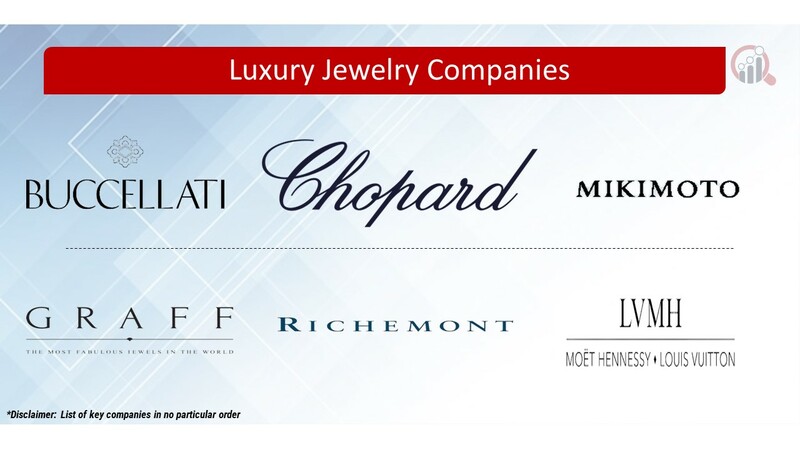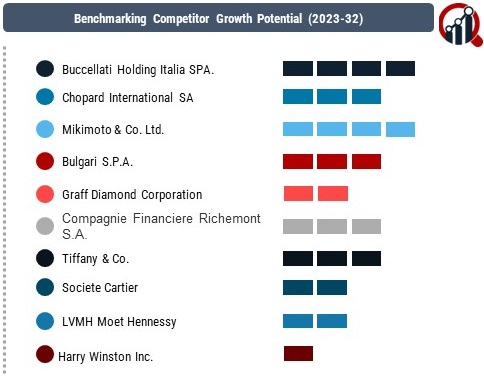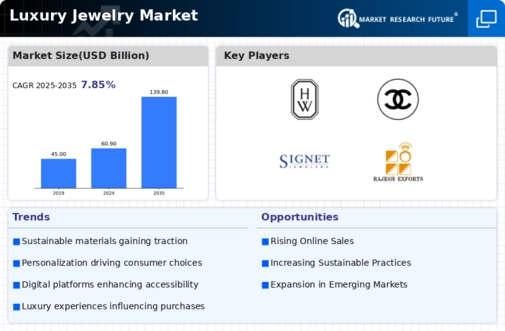Top Industry Leaders in the Luxury Jewelry Market

Market share analysis in the luxury jewelry segment is influenced by critical factors such as brand prestige, product exclusivity, and the ability to cater to changing consumer preferences. Pricing strategies play a pivotal role, with companies offering a range of jewelry pieces at varying price points to address diverse consumer segments. Establishing a strong retail presence in high-end shopping districts and exclusive partnerships with luxury retailers is essential for market share, ensuring the accessibility of luxury jewelry to high-net-worth individuals worldwide.
While established players dominate the luxury jewelry market, new and emerging companies are entering the scene with innovative approaches. These entrants often focus on niche markets, unique design aesthetics, and the integration of technology into jewelry pieces to differentiate themselves. The agility of these emerging companies allows them to swiftly adapt to changing consumer tastes, challenging the market dominance of established brands and contributing to the overall dynamism of the market.
Industry news within the luxury jewelry market frequently highlights exclusive launches, collaborations, and evolving consumer trends. Companies regularly introduce limited-edition collections, collaborate with high-profile influencers and celebrities, and participate in prestigious events such as fashion weeks to enhance brand visibility and desirability. Regulatory updates related to ethical sourcing practices, responsible mining, and corporate social responsibility initiatives shape industry dynamics, prompting companies to align their practices with evolving standards.
Current trends in company investments within the luxury jewelry market reflect a notable focus on sustainability, technology integration, and digital marketing. Companies allocate resources to source responsibly mined gemstones, explore eco-friendly materials, and adopt ethical practices in their supply chains. Strategic marketing initiatives, including digital advertising, social media engagement, and influencer partnerships, are employed to strengthen brand presence and resonate with the target consumer demographic. Investments in technology, such as augmented reality for virtual try-ons and blockchain for traceability, align with the industry's drive towards innovation.
The overall competitive scenario in the luxury jewelry market remains dynamic, with companies navigating changing consumer preferences and the evolving landscape of luxury retail. Established players face the challenge of maintaining and enhancing brand exclusivity in a market where emerging companies are leveraging unique design concepts and sustainable practices to differentiate themselves. The competition is expected to intensify as new entrants gain recognition, introducing fresh perspectives and challenging the market share of established brands. In this environment, adaptability, responsiveness to consumer trends, and a commitment to innovation and sustainability will be crucial for companies to maintain and enhance their competitive positions in the luxury jewelry market.
Industry News and Investment Landscape:
- Acquisitions in the recent past, like as LVMH's acquisition of Tiffany & Co., point to patterns of consolidation in the high-end market.
- A focus on potential development areas is indicated by increased investments in online platforms, technology-driven customisation, and ethical sourcing activities.
- Influencer alliances, premium partnerships, and rising trends in digital marketing on social media offer brands both advantages and disadvantages.
Key Companies in the Luxury Jewelry Market Include –
- Buccellati Holding Italia SPA.
- Chopard International SA
- Mikimoto & Co. Ltd.
- Bulgari S.P.A.
- Graff Diamond Corporation
- Compagnie Financiere Richemont S.A.
- Tiffany & Co.
- Societe Cartier
- Harry Winston Inc.
- Guccio Gucci S.P.A.
- Chanel
- LVMH Moet Hennessy
- Signet Jewelers
- Cartier International SNC
- Rajesh Exports Ltd.


